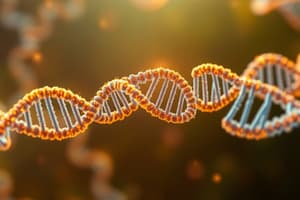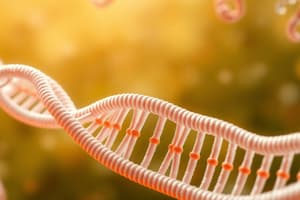Podcast
Questions and Answers
What feature characterizes rho-independent terminators?
What feature characterizes rho-independent terminators?
- They contain inverted repeats and a string of guanine nucleotides.
- They cause RNA polymerase to speed up during transcription.
- They require rho factor proteins for termination.
- They consist of inverted repeats followed by a string of adenine nucleotides. (correct)
How does the presence of a hairpin in an RNA transcript affect RNA synthesis?
How does the presence of a hairpin in an RNA transcript affect RNA synthesis?
- It prevents the formation of uracil nucleotides.
- It accelerates RNA polymerase activity.
- It destabilizes the DNA-RNA pairing, leading to termination. (correct)
- It allows for the continuous synthesis of RNA without interruption.
What role does the rho factor play in rho-dependent termination?
What role does the rho factor play in rho-dependent termination?
- It synthesizes ribonucleoside triphosphates.
- It stabilizes the RNA molecule during synthesis.
- It breaks the hydrogen bonds between DNA and RNA. (correct)
- It prevents the formation of hairpin structures.
What is the direction of RNA synthesis during transcription?
What is the direction of RNA synthesis during transcription?
Which of the following statements reflects a characteristic of transcription?
Which of the following statements reflects a characteristic of transcription?
What type of substrate is used in the process of RNA synthesis?
What type of substrate is used in the process of RNA synthesis?
What is the primary function of RNA polymerase in transcription?
What is the primary function of RNA polymerase in transcription?
Why are combinations of adenine and uracil in RNA considered relatively unstable?
Why are combinations of adenine and uracil in RNA considered relatively unstable?
What is the role of the sigma factor during the initiation step of transcription?
What is the role of the sigma factor during the initiation step of transcription?
Which of the following best describes what happens after the sigma subunit is released during the elongation phase?
Which of the following best describes what happens after the sigma subunit is released during the elongation phase?
During elongation, what is the significance of the transcription bubble?
During elongation, what is the significance of the transcription bubble?
What is a primary characteristic of the types of terminator sequences in prokaryotes?
What is a primary characteristic of the types of terminator sequences in prokaryotes?
Which statement correctly describes the role of RNA polymerase during transcription?
Which statement correctly describes the role of RNA polymerase during transcription?
What initiates the transcription process at the promoter region?
What initiates the transcription process at the promoter region?
What is the first nucleotide in an RNA transcript?
What is the first nucleotide in an RNA transcript?
Which of the following statements about transcription is NOT true?
Which of the following statements about transcription is NOT true?
What is the role of the sigma factor in RNA polymerase function?
What is the role of the sigma factor in RNA polymerase function?
Which RNA polymerase is responsible for synthesizing mRNAs in eukaryotic cells?
Which RNA polymerase is responsible for synthesizing mRNAs in eukaryotic cells?
What element is best characterized as a core promoter element in eukaryotes?
What element is best characterized as a core promoter element in eukaryotes?
Where are the promoter proximal elements located in relation to the core promoter?
Where are the promoter proximal elements located in relation to the core promoter?
What role do transcription regulatory proteins play in eukaryotic transcription?
What role do transcription regulatory proteins play in eukaryotic transcription?
Which transcription factor is necessary for high-level gene transcription?
Which transcription factor is necessary for high-level gene transcription?
What characteristic of AT-rich DNA affects its denaturation compared to GC-rich DNA?
What characteristic of AT-rich DNA affects its denaturation compared to GC-rich DNA?
Which of the following is NOT a function of RNA polymerase?
Which of the following is NOT a function of RNA polymerase?
What is the primary function of adding adenine nucleotides to the 3' end of mRNA?
What is the primary function of adding adenine nucleotides to the 3' end of mRNA?
Which statement about introns and exons is correct?
Which statement about introns and exons is correct?
What structure is responsible for the splicing of introns from pre-mRNA?
What structure is responsible for the splicing of introns from pre-mRNA?
During the splicing process, where do introns typically begin and end?
During the splicing process, where do introns typically begin and end?
What occurs immediately after the cleavage at the 5' end of an intron during splicing?
What occurs immediately after the cleavage at the 5' end of an intron during splicing?
How does RNA editing affect the relationship between RNA and DNA sequences?
How does RNA editing affect the relationship between RNA and DNA sequences?
What can be a consequence of RNA editing in terms of protein production?
What can be a consequence of RNA editing in terms of protein production?
Which of the following best describes the role of snRNPs in the splicing process?
Which of the following best describes the role of snRNPs in the splicing process?
What is the primary function of ribosomal RNA (rRNA)?
What is the primary function of ribosomal RNA (rRNA)?
Which statement correctly characterizes the structure of prokaryotic ribosomes?
Which statement correctly characterizes the structure of prokaryotic ribosomes?
What is the significance of the term 'Svedberg units' in relation to ribosomes?
What is the significance of the term 'Svedberg units' in relation to ribosomes?
How do the structures of eukaryotic tRNAs typically differ from those of prokaryotic tRNAs?
How do the structures of eukaryotic tRNAs typically differ from those of prokaryotic tRNAs?
What role does the anti-codon loop in tRNA play during translation?
What role does the anti-codon loop in tRNA play during translation?
What is the total sedimentation rate of mammalian ribosomes?
What is the total sedimentation rate of mammalian ribosomes?
Which of these is NOT true about ribosomal RNA (rRNA) genes in eukaryotes?
Which of these is NOT true about ribosomal RNA (rRNA) genes in eukaryotes?
What is the main structural characteristic of tRNA that enables its function?
What is the main structural characteristic of tRNA that enables its function?
Flashcards are hidden until you start studying
Study Notes
Transcription: The Process of Making RNA
- Transcription is the process of copying genetic information from DNA to RNA.
- It occurs in three steps: initiation, elongation, and termination.
- Transcription is essential for gene expression and protein synthesis.
Initiation
- RNA polymerase (RNAP) is the primary enzyme responsible for transcription.
- RNAP binds to DNA at specific sequences called promoters.
- Promoters contain consensus sequences, such as the -35 and -10 regions, that help RNAP recognize and bind to the DNA.
- Promoters often include TATA boxes, which are AT-rich sequences that help unwind the DNA.
- Sigma factors help RNAP bind to promoters efficiently.
- Different sigma factors can regulate the transcription of different genes.
- Once RNAP binds to a promoter, it unwinds the DNA to create a transcription bubble.
- RNAP begins transcribing at the start site of the gene, located within the transcription bubble.
- The first nucleotide on the RNA transcript is always a purine triphosphate (GTP or ATP).
Elongation
- RNAP moves along the DNA template in a 3' to 5' direction.
- As RNAP moves, it reads the DNA sequence and adds complementary ribonucleotides to the growing RNA chain.
- The RNA chain is synthesized in a 5' to 3' direction.
- Elongation involves the addition of ribonucleoside triphosphates (NTPs) to the free 3' hydroxyl group of the growing RNA strand.
- The process is highly accurate, with errors occurring at a rate of about 1 in 10,000 nucleotides.
Termination
- Termination marks the end of transcription.
- RNAP stops moving along the DNA template and releases the newly synthesized RNA transcript.
- Termination can occur by several mechanisms:
- Rho-independent termination: involves sequence elements within the DNA template that cause the RNA transcript to form a hairpin structure. This structure destabilizes the RNA:DNA hybrid, leading to dissociation of the transcript from the template.
- Rho-dependent termination: involves the rho protein, which binds to the RNA transcript and disrupts the RNA:DNA hybrid by unwinding the RNA:DNA duplex, leading to termination.
Transcription in Eukaryotes
- Eukaryotes have three RNA polymerases:
- RNA polymerase I: responsible for transcribing ribosomal RNA (rRNA).
- RNA polymerase II: responsible for transcribing messenger RNA (mRNA).
- RNA polymerase III: responsible for transcribing transfer RNA (tRNA) and some small nuclear RNAs (snRNAs).
- Eukaryotic transcription requires additional regulatory elements beyond promoters.
- These elements include promoter proximal elements (located upstream of the core promoter) and enhancers (located further upstream or even downstream of the gene).
- Transcriptional regulatory proteins (activators) bind to enhancers to stimulate transcription.
Post Transcriptional Processing in Eukaryotes
- Eukaryotic transcripts undergo post-transcriptional processing before they can be translated into proteins.
- 5' capping: a modified guanine nucleotide is added to the 5' end of the mRNA. This cap protects the mRNA from degradation and helps it bind to ribosomes during translation.
- 3' polyadenylation: a poly(A) tail is added to the 3' end of the mRNA. This tail protects the mRNA from degradation and helps it exit the nucleus.
- Splicing: non-coding sequences called introns are removed from the pre-mRNA, leaving behind the coding sequences called exons. Splicing is carried out by a complex called the spliceosome.
- RNA editing: some RNAs are edited after transcription through chemical modifications or base substitutions.
- All these modifications are essential for proper gene expression.
Non-coding RNAs
- Some genes do not code for proteins but produce non-coding RNAs (ncRNAs).
- These ncRNAs have diverse roles in gene regulation and cellular processes.
- Examples of ncRNAs include:
- rRNA: essential for protein synthesis.
- tRNA: involved in translation.
- snRNAs: part of the spliceosome that plays a critical role in RNA splicing.
Ribosomes and Ribosomal RNA (rRNA)
- Ribosomes are essential for protein synthesis.
- Each ribosome consists of two subunits, a large subunit and a small subunit.
- Ribosomes contain rRNA and ribosomal proteins.
- rRNA is transcribed by RNA polymerase I.
- Eukaryotic rRNA genes are typically arranged in tandem repeats, creating numerous copies of rRNA genes within the genome.
Transfer RNA (tRNA)
- tRNA molecules transport amino acids to the ribosome during protein synthesis.
- Each tRNA molecule has a specific anticodon sequence that recognizes a specific codon in mRNA.
- tRNA is transcribed by RNA polymerase III.
- tRNA genes can be found in repeated copies within the genome.
- tRNA molecules undergo post-transcriptional modifications, including chemical modifications of bases.
- Modified bases contribute to the structure and function of tRNAs.
Studying That Suits You
Use AI to generate personalized quizzes and flashcards to suit your learning preferences.




